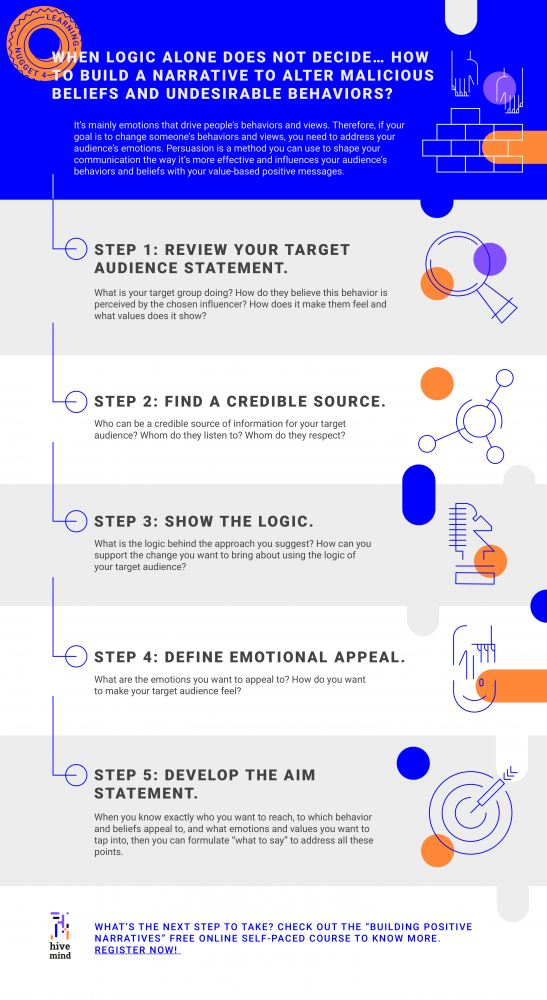Although you may be prepared to support your campaign and its goal with tons of data, and you can say how perfectly logical it would be to act the way you promote, you need to face the fact that less than 10% of the population makes choices based on information alone. For most of us, human beings, it is by showing your values, addressing our emotions, how you can gain supporters and impact the way we act or think. It’s not that data and logic don’t count, they still need to be in place, but they usually don’t attract attention, unless they are already in alignment with the world view or assumptions we have. If they aren’t, our brains can easily ignore them when seen in social media feeds or other spaces where there is a lot of content (yes, we are all susceptible to confirmation bias).
So, where should we begin?
Research shows that narratives can impact an individual’s attitudes, beliefs, and behaviors. To create a narrative, you need to know who you want to talk to and what emotions drive your audience, and then formulate the right form of persuasion.
Persuasion is learning with an emotional dimension, altering current beliefs and emotional payoffs. Note that the components of persuasion are a direct response to our target audience statement (in case you don’t have one, check this guide to create it).
There are three elements necessary for persuasion to work:
Credible source: a person that the audience trusts
Logical approach: presenting new bits of knowledge, skills, or attitudes in the way the audience recognizes and understands
Emotional appeal: a negative or positive emotion to encourage the new piece of knowledge, skills, or attitudes.
CREDIBLE SOURCE
Credible sources are people that your audience trusts. We break those sources down into five categories: 1) people like us (the most influential), 2) celebrities, 3) role models, 4) community leaders, and finally 5) experts (still perceived as credible, but least influential).
LOGICAL APPROACH
Look at what your target audience believes in. Note that you need to spot the logic your target audience follows, not your own. By choosing an influencer and the agreed realities they are linked to, you can decide what you want to change.
EMOTIONAL APPEAL
To persuade someone to follow your narrative, you need to activate their emotions or feelings. Logic alone does not persuade anyone to do anything. Emotion is a tremendous driver that alters our current understanding and is linked to the formation of memory. When we understand what the audience’s emotional payoffs are, we can examine alternatives that can challenge a fixed pattern of thinking.
It is important to note that your persuasion needs to include a value shift. It is not very likely that we accept new chunk of knowledge, skills, or attitudes if we are not encouraged to do so. Encouragement either comes from a shift from a value to an opposite value (from a positive to a negative one, or vice versa) or it can be an amplification of the value (from positive to a very positive one, or from negative to a very negative one).
AIM STATEMENT
Once you understand who you are talking to, the aim provides the knowledge of “what to say”. To create an aim you need your target audience statement (if you don’t already have it, check out this step by step guide on how to do it).
Your aim statement = target audience statement + credible source + logical approach + emotional appeal
For example, we want to target “some teenage girls who believe drinking alcohol is making them equal to older siblings’ friends, whom they believe shall perceive them as cool and mature because of this, and therefore they will feel accepted” (to see how this example was developed, look here).
Your aim statement then includes the target audience + the logic approach + the emotional appeal. Hence, in this case, our aim is to persuade these teenage girls to believe that "drinking alcohol makes them seem to be attention seekers to older siblings’ friends who see them as immature and pretentious, and therefore these girls would feel rejected".
On the basis of this aim statement, you can now develop a positive alternative narrative that would suggest to the target audience how differently they could formulate the needs and values that are important to them and how a different behavior could make them feel.
Of course, any persuasion targeting attitude (belief) change or behavior change will not affect all the members of a given community in the same manner. Some of them will be quick to change, others will be slow to change and will need repeated examples of the new idea. Some members will be very hard to change or even: may never change. This is why it’s best to develop your narratives in a strategic way and communicate them skillfully and flexibly.
If you want to learn more about how to effectively use the aim statement and weave persuasion into your communication, join our free online course in “Building Positive Narratives”.

Like this infographic? You can download it for free here!
